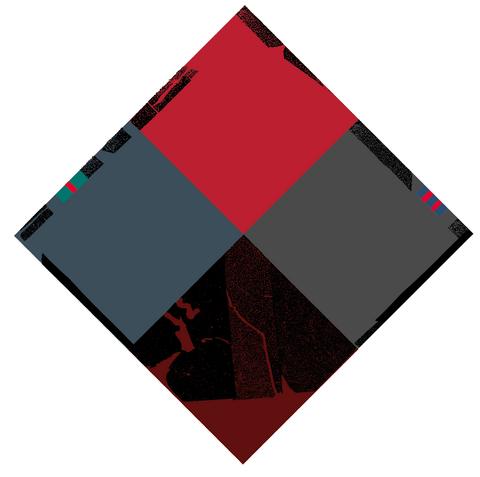"The bases for artistic ideas can be many and various. But to me, the most important thing is a national basis, a traditional orientation," said Lee Hsi-chi (
In Ten Aspects of My Artistic Life (浮生十帖), Lee's current exhibition at the National Museum of History (國立歷史博物館), the 64-year-old painter is showing his latest experiments with rearrangeable plates on which his pet medium -- lacquer -- is used to bring life to a limited variety of colors presented on a metal surface.

PHOTO COURTESY OF NMH
Pleasure, stimulation, monologue, understanding, sadness, an unscarred heart, new worries, happiness, brilliance and dynamism are the subjects of the ten large-format works. The composition of the works, however, is in flux, because they are each made up of several modular rectangular plates. Lee will rearrange them a couple of times during the course of the exhibition to give them a new appearance.

PHOTO COURTESY OF NMH
Creating paintings that can be rearranged is an idea Lee has worked on for a decade. Playing a Tangram puzzle he bought as a souvenir in Japan on a sleepless night gave him the idea that paintings could also be moved around like this.
Later when traveling in China's Hubei province, Lee was thrilled by its famous traditional lacquer artefacts. The lacquer objects are left to dry in extreme temperatures, resulting in a cracked surface that is then rubbed smooth.
The cobweb of cracks fascinated Lee, who saw a way of giving the rigid painted surface an organic aspect.
He went to Fuzhou in China, also an important lacquer center, where he learn the whole lacquer process. China is the place Lee often finds his artistic inspiration, while many younger artists have turned to things more "local" or "Taiwanese."
"Artists of my generation favor the `Chinese sentiments.' Nowadays Taiwanese are much influenced by politics. Art has become a political language.
"Art should stay untouched by political trends. It is best if artists reflect local qualities visually. Expressing the `regional' can make really great works. But they should lift the quality of their works to international standards," Lee said.
Lee has been active since the 1950s, teaming up with Yuyu Yang (
Over the past 20 years, Lee has devoted himself to expanding the frontiers of painting. His Great Calligraphy series, which detached the meaning from Chinese characters and treated the brush strokes as individual symbols, marked his highest achievement in this style.
Also on show is Lee's late 1990s series A Passage to Solitary Darkness, Memories of the Far and Re-orientation , the last being Lee's best-known series.
Re-orientation was a follow-up to the much earlier Orientation, which applied pop-art ideas to Chinese imagery, and Post-orientation, similarly dealing with Chinese calligraphy.
What: Ten Aspects of My Artistic Life -- Lee Hsi-chi solo exhibition
Where: National Museum of History, No. 49, Nan-hai Rd., Taipei.
When: until Feb. 3

April 14 to April 20 In March 1947, Sising Katadrepan urged the government to drop the “high mountain people” (高山族) designation for Indigenous Taiwanese and refer to them as “Taiwan people” (台灣族). He considered the term derogatory, arguing that it made them sound like animals. The Taiwan Provincial Government agreed to stop using the term, stating that Indigenous Taiwanese suffered all sorts of discrimination and oppression under the Japanese and were forced to live in the mountains as outsiders to society. Now, under the new regime, they would be seen as equals, thus they should be henceforth

Last week, the the National Immigration Agency (NIA) told the legislature that more than 10,000 naturalized Taiwanese citizens from the People’s Republic of China (PRC) risked having their citizenship revoked if they failed to provide proof that they had renounced their Chinese household registration within the next three months. Renunciation is required under the Act Governing Relations Between the People of the Taiwan Area and the Mainland Area (臺灣地區與大陸地區人民關係條例), as amended in 2004, though it was only a legal requirement after 2000. Prior to that, it had been only an administrative requirement since the Nationality Act (國籍法) was established in

With over 80 works on display, this is Louise Bourgeois’ first solo show in Taiwan. Visitors are invited to traverse her world of love and hate, vengeance and acceptance, trauma and reconciliation. Dominating the entrance, the nine-foot-tall Crouching Spider (2003) greets visitors. The creature looms behind the glass facade, symbolic protector and gatekeeper to the intimate journey ahead. Bourgeois, best known for her giant spider sculptures, is one of the most influential artist of the twentieth century. Blending vulnerability and defiance through themes of sexuality, trauma and identity, her work reshaped the landscape of contemporary art with fearless honesty. “People are influenced by

The remains of this Japanese-era trail designed to protect the camphor industry make for a scenic day-hike, a fascinating overnight hike or a challenging multi-day adventure Maolin District (茂林) in Kaohsiung is well known for beautiful roadside scenery, waterfalls, the annual butterfly migration and indigenous culture. A lesser known but worthwhile destination here lies along the very top of the valley: the Liugui Security Path (六龜警備道). This relic of the Japanese era once isolated the Maolin valley from the outside world but now serves to draw tourists in. The path originally ran for about 50km, but not all of this trail is still easily walkable. The nicest section for a simple day hike is the heavily trafficked southern section above Maolin and Wanshan (萬山) villages. Remains of